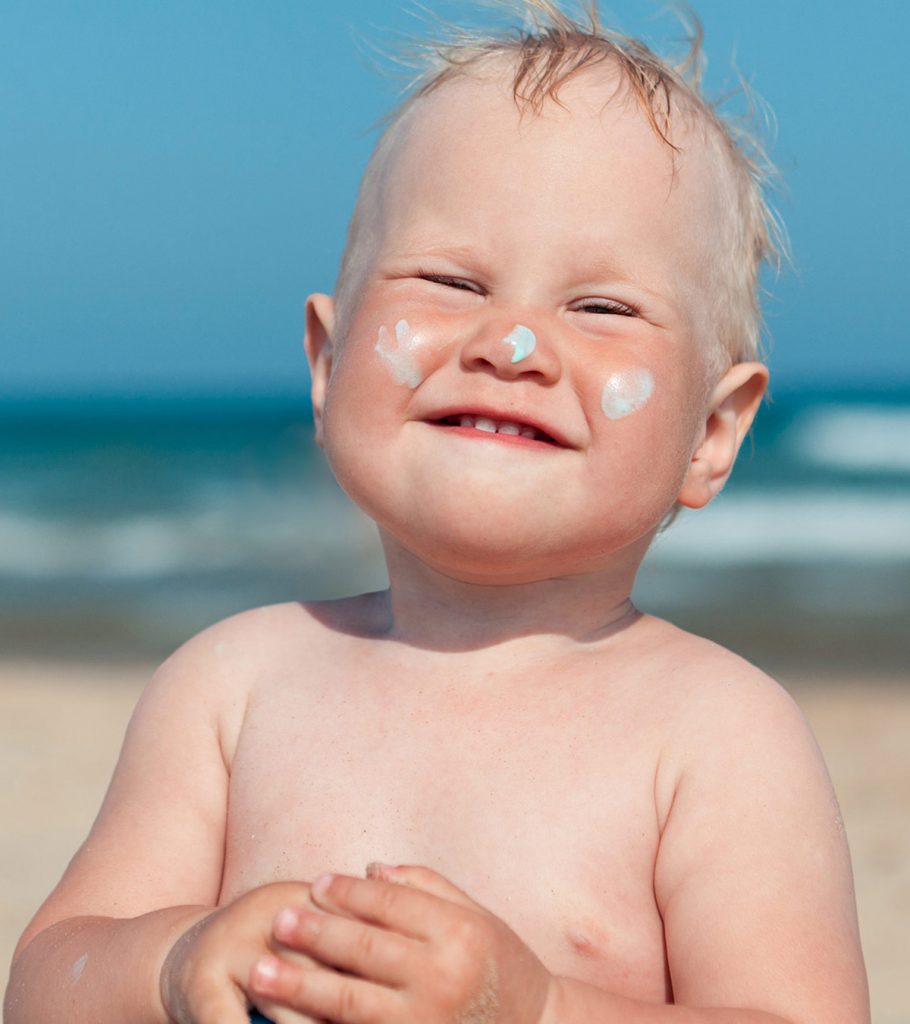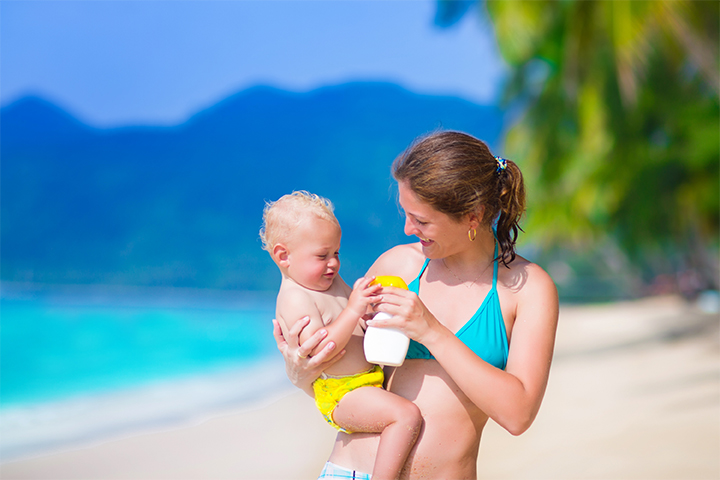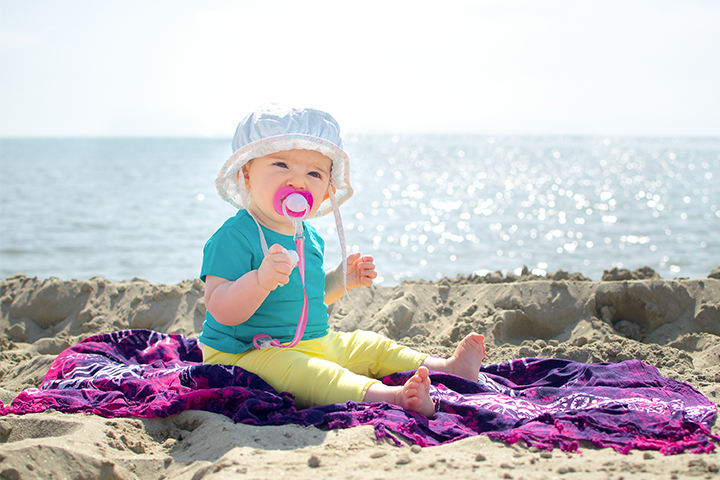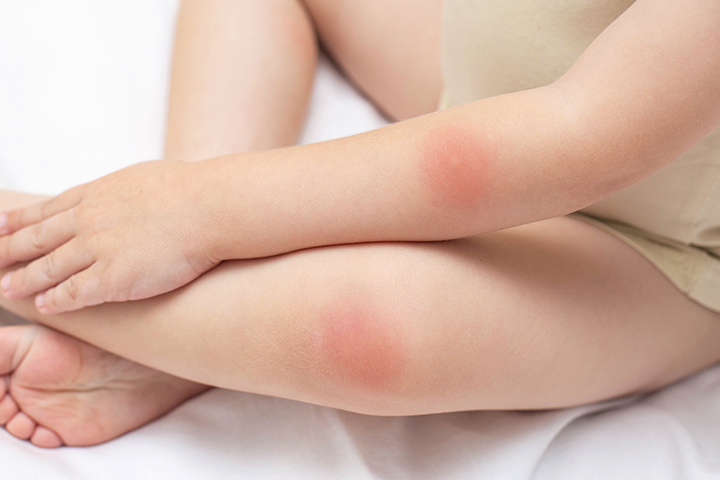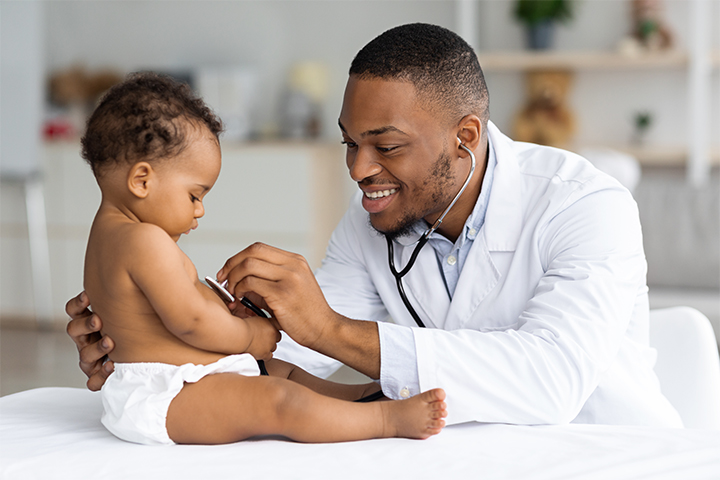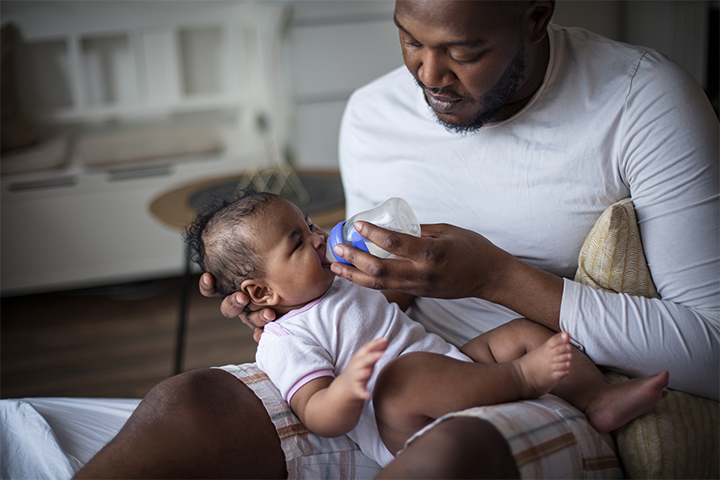Sunburn in babies can cause discomfort and be quite painful for them to endure. Sunburn occurs when your skin is excessively exposed to the ultraviolet (UV) rays of the sun (1). Our skin produces a pigment known as melanin to protect itself from sun damage. However, if the intensity of the UV radiation exceeds the melanin’s ability to protect the skin, the person can get sunburn. Thus, the fairer a person’s skin, the more likely they are to land up with a sunburn.
The more natural melanin pigment one’s skin produces, the lesser the chances of getting a sunburn. And since the damage caused to the skin is just like a burn, it’s referred to as sunburn. In this post, we tell you how to protect your baby’s skin from sunburn and the dos and don’ts if your baby has sunburn.
How Does A Baby Get Sunburn?
Here are the reasons why sunburns are caused in babies (2) (3):
- Not wearing sunscreen is the most common reason that makes babies susceptible to sunburn. Even spending a few minutes under the sun without sunscreen can cause sunburns in infants.
- Lack of a physical barrier like a hat or an umbrella against the sun exposes the baby to the UV rays, causing sunburns.
- Spending too much time outdoors during the day, especially between 10 am and 4 pm, when the sun rays are at their strongest, is indeed a bad idea. The rays are harsher in summer and must be avoided.
- Being light-skinned (meaning less natural melanin pigment in the skin) can mean more chances of sunburn. Babies with a light skin tone have less melanin. Direct sun exposure for just 15 minutes can give them a sunburn. Those with darker skin can usually tolerate the sun for an hour but can still get sunburnt.
- Skin conditionssuch as lupus, an autoimmune disease, can increase the sensitivity of the baby’s skin, thus accelerating the development of sunburns.
- Some medicines, such as the antibiotic doxycycline, make the skin vulnerable to sunburn as a side effect.
The causes of sunburn mostly are preventable. Thus, it is ideal to take necessary preventive measures to save your baby from sunburn.
How To Prevent Sunburn In Babies?
To prevent sunburn (4):
- Minimize sun exposure. Pediatric experts state that infants below the age of six months should not be exposed to direct sunlight (5). If you have to take your baby out during the afternoon, then make sure you keep them in the shade. An umbrella works well, but a canopy offers better protection. Staying indoors during the daytime is ideal.
- Use sunscreen: Seek pediatric guidance and choose a broad-spectrum infant sunscreen that protects them against UVA and UVB rays. Select one with a sun protection factor (SPF) of 15 to 30. Apply sunscreen about 15 minutes before going out in the sun and use a waterproof sunscreen if you are planning to take the baby to the beach or the swimming pool. Do note that sunscreens should not be applied to babies below the age of six months (6). Physical barriers and avoiding the sun are the best options for them.
- Dress the infant in long-sleeved cotton clothes: Long-sleeved cotton clothing helps protect from skin damage and enables ventilation. Give preference to white-colored clothing since white can reflect the sunlight away from the body.
- Use sunglasses and hat: Use a wide-brimmed hat that snugly fits your baby’s head. The hat should cover a wide area around the head and the delicate skin of the face.
How To Tell If The Baby Has A Sunburn?
The first signs of sunburn appear six to 12 hours after exposure to the sun (5). You will notice the following symptoms of sunburn in babies:
- Redness of the skin: The sunburnt skin would be red to dark pink. You may even observe the outline of the sunburn if the clothes partially protect the body.
- Warm skin: Sunburnt skin feels warm when touched, even after you move your baby to a cooler place.
- Redness, inflammation, and soreness in the eyes: The eyes become red, watery, and may feel sore when sunburnt. The baby may also blink frequently due to the irritation.
- Other symptoms that could also be present are swelling, a rash, and dry and itchy skin.
Usually, sunburn does not cause anything beyond the redness and tenderness of the skin. But in some cases, there can be extensive damage to the skin, and you will have to take the baby to the doctor.
When To Visit The Doctor For A Baby’s Sunburn?
Sunburn in babies needs immediate medical intervention when the infant displays the following symptoms (7) (8):
- Blisters on the sunburnt skin, which usually emerge a few to several hours after exposure
- Fever and chills
- Fussiness
- Decrease in appetite
- Severe pain in the affected area and the baby seems irritable when the dermis comes into contact with anything
- Acute inflammation of the eye or the baby has trouble with vision
Extensive sunburns can even cause dehydration and heatstroke. If the baby shows any of the symptoms mentioned above, take them to a doctor.
Symptoms of sunburn are at their worst 24 hours after sun exposure and usually go away within five to seven days, with proper home care.
What To Do If A Baby Gets A Sunburn?
Here is what you should do if the baby gets sunburnt (8) (9):
- Give the baby a cool water bath. Cool water baths can soothe the baby’s sunburnt skin. Avoid adding oatmeal or baking soda since you may not know how the baby’s skin would react to it. Pat-dry the affected area after the bath.
- Apply cool water compress. Soak a towel in cool water and put it on the affected area for several minutes. Do not rub the area with the damp towel; instead, gently place it on the sunburnt skin. In the case of sunburnt eyes, you can put a damp cloth on the eyes lightly, without adding any pressure.
- Use water-based moisturizers. Apply a safe, water-based moisturizer to the skin. You can even use an aloe-based skin gel. These skin applications help soothe the pain and burning sensation while also rehydrating the burnt skin.
- Keep the surroundings cool and well-ventilated. Ensure that the baby’s room is pleasant, with a cool breeze and adequate ventilation.
- Dress the baby in loose clothes. Loose clothing reduces the chafing of sunburnt skin, preventing blisters from bursting. Natural fibers like cotton are good since they allow the skin to breathe.
- Use loose bandages for blisters. If the baby develops blisters, cover them with loose gauze bandages that facilitate ventilation, and prevent the baby from picking at the blisters. Blisters subside without bursting once the sunburn heals. If the blister bursts naturally, then wipe it clean with cotton dipped in antibiotic liquid and dress with a gauze bandage.
- Give them plenty of fluids. Give the little one plenty of fluids to reduce the sensation of heat on the sunburnt skin. If the baby is younger than six months old, then increase the number of feeds. Infants older than six months can be given frequent sips of water in addition to breast milk.
- Consider appropriate medication. Medicines like acetaminophen and ibuprofen reduce pain while a cortisone cream alleviates inflammation. Consult the baby’s pediatrician to learn about the medicines you can use for sunburns.
Pediatricians usually recommend topical antibiotics to prevent infection due to the ruptured blisters. The doctor may also suggest anesthetic eye drops to alleviate pain in the case of sunburnt eyes.
What Not To Do If A Baby Has A Sunburn?
Avoid these when your baby has a sunburn (10) (11):
- First-aid creams, in general, contain compounds like benzocaine or lidocaine that could irritate the skin and even cause a skin allergy.
- Do not use any pain medications without doctor consultation. Some medicines that work well for adults may have harmful side-effects in children and babies.
- Petroleum-based and oil-based creams, as they block the skin pores, preventing heat and sweat from escaping. They might prevent the sunburnt skin from cooling down and could also prevent blisters from drying. Stick to water-based moisturizers and gels.
- Never pop the blisters no matter how ballooned they seem. Bursting a blister is not going to make the skin heal faster. If the blisters rupture, it could lead to infections. You can use a topical antibiotic to prevent infection.
- Peel the dry, sunburnt, and flaky skin on top, which is formed as the skin heals. Let the dead skin shed naturally and avoid peeling it off forcefully. When blisters burst naturally, they also leave a dead layer of skin, which falls off on its own.
- Further sun exposure will not make sunburn better. So, avoid taking the baby out in direct sunlight until the skin heals.
When babies get sunburnt, the most affected areas are usually on the face, the eyes, and the delicate skin around them.
Can Babies’ Eyes Get Sunburned?
Yes. Even an infant’s eyes are susceptible to sunburn. The sunburn of the eyes is called photokeratitis. It causes redness, irritation, and inflammation in the eyeball. In extreme cases, it could result in blurry vision too (5).
Not wearing protective sunglasses with UV protection can result in photokeratitis.
What Are The Risks Of Baby Sunburn?
Sunburns may seem very common but can have short- and long-term adverse effects. Frequent or multiple sunburns can cause premature aging and invisible damage to the baby’s skin. UV radiation from sun exposure may cause DNA mutations in the skin cells, which may increase the risk of skin cancer (12) (13). The risk of skin cancer in children is higher if they have freckles, moles, recurrent blistered sunburns, and a family history of skin cancer (8). Research suggests that the more sunburns one encounters, the higher the risk of cutaneous melanoma (a type of skin cancer), as skin damage keeps intensifying. Evidence suggests that even one severe sunburn in childhood may double this risk. However, regular sunscreen use may help reduce the risk of these adverse isses (14) (15) (16).
Sunburn in babies could be prevented with the help of sunscreen, making them wear long-sleeved clothes and also reducing sun exposure to the minimum. If you see blisters on your child’s sunburnt areas and they show signs of fever and chills, consult your pediatrician immediately and seek medical guidance. If your baby has sunburns, ensure to maintain ample hydration, use proper medications, and avoid using any oil-based cream or moisturizers in the affected area. Take proper care of your baby and cover them well while out in the sun.
Key Pointers
- Not using sunscreen, being outdoors often, having a lighter skin tone, taking certain medications, and having certain skin conditions can cause sunburn in babies.
- To prevent sunburn in babies, it is recommended to avoid direct sun exposure, use sunscreen, wear sunglasses, hats, and long-sleeved clothing.
- Symptoms of sunburn in babies can include redness, warmth, blisters, fever, pain, and inflamed eyes.
- To treat sunburn in babies, a cool bath, cold compresses, water-based moisturizers, plenty of fluids, and appropriate medications (after consulting a doctor) can be helpful.
- However, it is important to avoid using first-aid creams, petroleum, and oil-based lotions as they can further irritate the baby’s skin.
Arm yourself with valuable information on shielding your baby from the sun’s harmful rays and treating sunburn if it occurs. Gain the facts you need through this informative video!
